Real dry rot (Serpula lacrymans [Wulf. Ex Fr.]) his livelihood



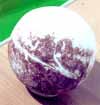

I. General information about the formation of wood damage and real dry rot
The infestation by fungi and insects destroying wood requires increased moisture, carbon compounds as an energy supplier and other nutrients, such as proteins and fats. The proportion of the nutrient substance in fresh wood is included Circa 5%.
If the wooden structure is built according to the constructive wood protection and if the wood moisture does not rise during the use, no serpular lacrymans can grow. If an attack occurs, penetration damage is usually the result. Previously, the causes were due to leaking roofs, broken roof drainage and broken water pipes in the winter. Today damage is caused by non-dense water pipes in the wooden beam ceiling (baths, hot water pipes, etc.) as well as condensation water on barrier layers and by a deficient execution of the interior insulation, eg in the removed attic.
Many of the minor damage to the wooden structure are not known to the house owner. But also visible wood damage is often misjudged and causes subsequent high renovation costs or problems when selling.
Basically, the real dry rot is a wood destroying fungus and not a disaster. The other wood-destroying fungi can also cause a very great damage and bring down supporting wooden constructions. The special feature of the serpula lacrimans is that it grows in the concealed space, that is, in cavities, and is therefore not recognized immediately.
This damage to the wood, the complete destruction of the ceiling beams under the bath, was caused not by the real house sponge, but by a wet rot fungus.
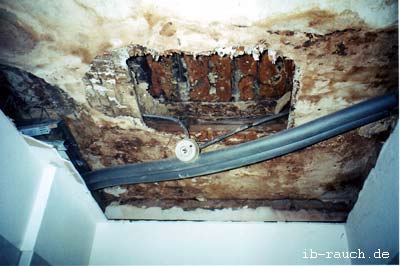
The real dry rot is part of the Genuine Fungi (Eumycota), Classiflora (Basidiomycetes), Order Aphyllophorales, Family Wartz sponges (Coniopharaceae), genera Coniophora and Serpula. In the Brockhaus an assignment to the hole mushrooms takes place. In Brockhaus biology the fungus is assigned to Porlingen with the name Merulius lacrimans (= Merulius domesticus). The family Porlinge, Poriaceae belongs, for example, to B. The white pore sponge, Poria vaporaria, is confused because of the similar damage pattern, brown dice fracture (destructive rot). The real dry rot is also known under the name Merulius lacrimans. The genus Merulius was set up by Fries according to purely external characteristics, which was certainly not possible at the time. Merriaceae, the light shoot species. From Persoon the brown-brown representatives were divided into the genus Serpula.
II. The typical damage pattern of the real dry rot
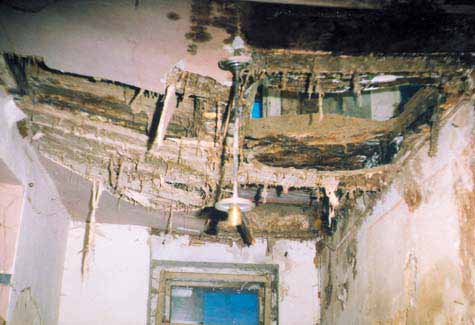
III. Growth factor for wood destroying fungi due to moisture
The fungi which occur in buildings are divided into three groups according to their moisture requirements
- Group only represented by the real dry rot(15-30 %)
- oup of wet rot fungi (30-80 %)
- Niedere Pilze ( ab 80 %)
The real dry rot es only a higher moisture content of about 30% to 40% at the beginning of its growth. The minimum is 17 to 20% and the maximum is 90%. (Coniphora puteana), a wood moisture of 45 to about 70% and the white pore (Poria vaporaria) 30 to 50%. For example, a high level of wood moisture is required by the Donkioporia expansa (white rot fungus), the damage of which can be considerable. This fungus often also occurs simultaneously with the real dry rot, as for example in the following picture.
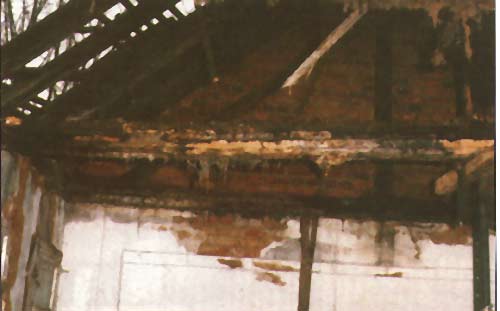
Depending on the degree of moisture grow certain wood destroying mushrooms. At the respective humidity level other fungi can not grow or grow very slowly. In the case of water line damage, local humidity is high, where the growth of wet rot fungi is more likely to occur, such as for example the Tapinella panuoides" or one of the other above-mentioned wet rot fungi ("Tapinella panuoides"). A fast and speedy drying of all wood and the other components is necessary. For example, in the wooden beam ceiling is the wood , The slag deposit and the adjoining masonry are dried. Thus, the mycelium of the real house sponge can not develop or develop only inadequately, since the optimum moisture for its growth is only available for a short time. If young mycelia is dried by Serpula lacrymans, it dies after a certain time. The phase of dryness depends on the size of the other environmental influences and certainly also on the strain itself.
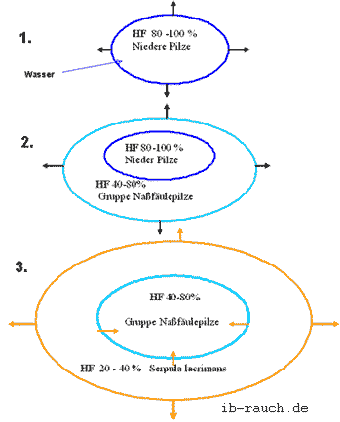
The relationship of a possible biological damage in a building with wooden structures will be shown in the diagram on the left. A water damage occurs which has not been determined and dried over a longer period of time. A complete local wetting of load-bearing timber constructions initially results in an infestation by low fungi or bacteria which grow at a wood moisture content of about 80 to 100% and cause a relatively small damage to the basal structure in the wood construction. If this moisture damage can spread, the marginal areas have a lower moisture content and provide favorable conditions for an attack by wood-destroying basidia (standing mushrooms) over a longer period of time. In the case of further spreading or drying to a wood moisture content of about 40%, favorable living conditions for the serpula lacrimans are produced. This fungus displaces the wet rot fungi and grows thus on the moist but also on the dry wooden construction.
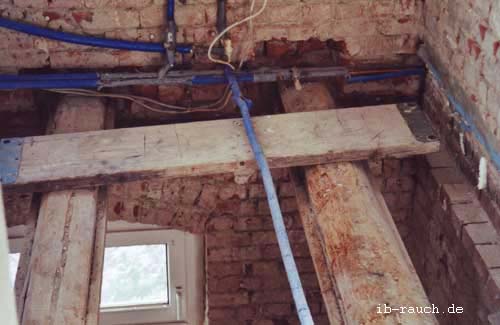
Due to the delayed damage detection as in the following picture, extensive damage can occur. Here the water line in the wooden beam ceiling was not properly soldered. Only after about 10 years the damage was determined over several rooms.
Moisture chambers with water vapor - saturated air are particularly beneficial for pilaf growth. If the relative humidity falls below 95%, the destructive activity of the house rot fungi diminishes significantly. The humidity is related to the substrate moisture.
All fungi produce water during their metabolic process. Water and carbon dioxide are released during the degradation of the cellulose.
They thus create a portion of the required moisture itself "breathing water". This type of trap is called dry rot. At a good Ventilation of the rooms and the construction, this water can be dissipated. The real house sponge has been particularly specialized and can thus also grow under the fiber saturation (with approx 30% moisture content).
The practice has shown that from a certain size, the mycelium can also spread on dry wood at a wood moisture content of 12%. Here, the necessary water is transported over the strand mycelium.
Examples of vulnerable areas where the air humidity can be very high due to insufficient ventilation:
- Dishwashers,
- unused outside toilet,
- Basements,
- Room corners behind cabinets and cold exterior wall,
- Faults in wooden beam ceilings on exterior walls, which are always subjected to rain,
- where the floorboards and floorboards are closed, and so on.
IV. Growth factor temperature for wood destroying fungi
Temperature as growth factors for the real dry rot
V. The influence of light and air exchange on the growth of wood destroying fungi
Fungi are free of chlorophyll and need no light for their growth, which is partly inhibitory. A certain amount of light is required for the formation of the fruit body. (G. Langendorf)
| Mushroom town | Increase in days in mm | |
|---|---|---|
| sunlight | Diffuse light | |
| Serpula lacrimans | 0 | 25 |
| Coniophora puteana | 25 | 80 |
| Antrodia vaillantii | 11 | 25 |
This shows why a fungus infection remains undetected for a relatively long time. They prefer darker and concealed premises. Since the real dry rot can cope with the other fungi with relatively low humidity, its infestation is mostly recognizable only when a larger damage is detected.
If sufficient continuous moisture supply is provided, such as, for example, Defective heating or water line, the Coniophora puteana causes a considerably greater damage at the same time.
Mushrooms which are exposed to the light are inevitably also subjected to an air exchange, which in turn means a moisture exchange. As already mentioned in the section "Moisture", fungi produce a portion of the water required, which is thus removed and thus reduces the metabolic process. The importance of drafts and the associated dehydration are described by various authors such as Grosser, Jennings and Bravery, Schmidt et al. Stressed.
VI. Function and characteristics of the mycelium of the real dry rot
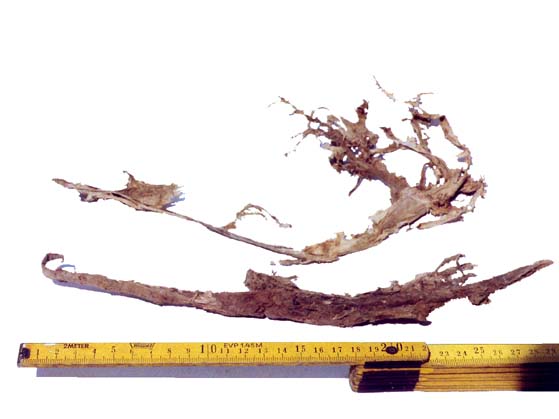
The surface mycelium is thick, cushion-shaped and initially snow-white, later gray, sometimes slightly yellowish, or even reddish-spotted. Older hyphae form oxalic acid crystals. The mycelium is also recognizable by the fact that it tears in fiber or growth direction. It can be easily detached from the support. The mycelium types are distinguished in aerial mycelium, surface mycelium, strands and intermediate mycelium. Very young mycelium can be distinguished macroscopically from the Coniophora puteana, which is white to yellowish and does not show any reddish spots. The strands of the EH are dirty gray and up to over 10 mm thick. Its shape is round, band-like, lappy or even assumes the shape of the cavity, which grows through. (In the joint of a door frame, the strand had assumed a square thickness of 1 cm.) The strands break in the dry state like wood of the same thickness. Thin mycelium also breaks. Especially in the Kellermauerwerk are also roots from nearby trees or bushes to be found.
The roots usually differ by their dark brown look and are very pliable. Likewise, they grow out of the wall and have no lighter mycelium. They are visually well distinguished from a fungus infection. The strands, with their strong rhizomorphs, sometimes up to 3 cm thick, can penetrate through masonry, even through the soil or under the pavement, to the neighboring building. These long mycelium strings represent a powerful water pipe system. It allows the fungus to attack even dry building parts and dry wood. (O. Schwantes 95 /S. 261-262) In Markkleeberg, the water was conducted from the passage of the water pipe in the cellar to the several square meters of mycelia and fruit bodies over a distance of approx. 10 m. On the surface of the water line was predominantly condensate. The mass transfer in the strands is coupled with the water transport and takes place via osmotic pressure equalization. Studies with various radioactive substances support this theory. (Weigl and Ziegler, 1960, Jennings and Bravery, 1991) The function of water discharge in fruit bodies and hypes peaks is not fully understood.
In the following picture you can see the mycelium of the Serpula lacrymans on the old ceiling beams and on the laterally attached side plates. The refurbishment was completely failed.
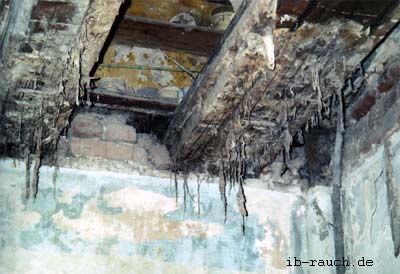
The mycelium can also penetrate components such as concrete. Only by H-J. Rafalski, the directional diagnosis diagnosis was developed as an important feature of the causes and damage elimination. The fruit body is usually found in an elliptical and round shape usually about 10 cm, but also up to 2 m2. The edge of the plate is usually bulging thickened, the centimeter-wide white growth edge being particularly striking. The fruit layer is rusty brown and wrinkled. The fruit body prefers diffuse light and can be found on the underside of wooden floors, on the cellar ceiling or rear-facing surfaces such as cupboards, couch, wall cladding. Growing fruit bodies smell pleasantly fungal, decomposing to petroleum. (A fungal odor is also present in the presence of larger amounts of mycelium.) The fruit body forms rusty spores and deposits like dust in corners. Older fruit bodies become dark to almost (black). If the fungus does not have sufficient "growth force", the brown spores form in a thin layer on the cotton-like mycelium. The brick- to brown-red spores are ellipsoidal and flattened on a bean-shaped side and have a size of 8 ... 12 micrometers times 4.5 ... 8 microns.
The fruit body of Serpula himantioides (wild house sponge) is somewhat smaller but difficult to distinguish from the real house sponge by morphological features. The species can be distinguished by genetic methods (Moreth-Kebernik and Schmidt 2000). Primarily, this type occurs in the open air and in high humidity also at the framework and never (?) at the masonry.
VII. The cytological processes
It can be assumed that various processes (exocytosis of enzymes for cell wall construction, release of cell wall building blocks and nutrient uptake) take place at the hyphal peaks. The catalytic activity of an enzyme is mainly dependent on substrate concentration, temperature and pH. If individual or all conditions are changed, the activity is reduced or even temporarily set. For example, A single enzyme molecule can decompose up to 5 million substrate molecules into its constituents within one minute. (Hubacek, 88, p. 29) At the tip of the hypha, the cell wall is permeable as well as plastic, thus facilitating an exchange with the environment. So far, the temporal or spatial relationships between the release of enzymes and cell wall polysaccharides as well as the metabolic processes in the stand fungi are only very little known. Basic investigations were scarce, only descriptions of the phenomenon exist. (Schmidt 1994)
VIII. The substrate and environmental influences
The role of moisture and temperature in relation to the growth condition was set forth in the above sections. In addition, other influencing factors have an effect in practice.
As already mentioned, the pH value plays an important role in enzyme activity. Building materials such as brick or sand are preferred by the fungi. They have a pH of 5-6. On the other hand, alkaline building materials such as lime, limestone, cement, concrete and wooden wool panels are rather inhibitive. (Weißenfels) In an approx. 60-70 years old villa, the concrete hollowed-out dikes were completely grown.
The alkaline effect as a growth brake is here greatly reduced by the carbonation.
In the normal state of the concrete by its Ca(OH)2 solution, the pH value is 12.6. For porous concrete, where Ca (OH)2 is carbonated by C02, the pH value at 8-10. Likewise, the pH of concrete decreases and Cement plasters, as they emit CO 2 over a long period of time, while the binding force is also reduced in the case of lime plasters.
In the WTA-instructions it is pointed out that alkaline materials as mentioned above are required by the real dry rot in order to neutralize the oxalic acid it produces. (WTA-instructions, p. 4). This is probably an intermediate product in the citrate cycle of the decomposition of the carbon molecule chains. The white pore sponge (antrodia vaillantii) neutralizes, for example, chemically protected wood in which copper compounds are present.
The increased oxalic acid production produces copper oxalate, which precipitates. Other constituents, such as chromium and arsenic compounds, lose their fixation and become water-soluble. (Wood preservation meeting 2000) Several older relatively smaller active flocks (approx. 1 - 2 m2) were plastered several years ago by the tenant himself with new new lime plaster. Growth came to a standstill. The old mortar in the wall joints still showed the mycelium and the new plaster no mycelium. The same can be observed when the masonry consists of different building materials, such as bricks and sand-lime bricks. Here, a very small boundary area is present in the course of the other building material. In practice, this can be a retrospectively constructed brick wall. Sand-lime bricks are also covered by the mycelium, as is the case with brick. However, the brick is more porous and the mycelium grows in these joints. The mycelium grows predominantly in the joints when the masonry is made of stones made of clay. If a strong attack is present, the mycelium is also found in the mudstone. In the case of parchment clay walls, the straw is removed. The mycelium grows through the entire moist wall cross-section. Thus, the area of infestation can also spread to completely dry wall sections of the pile clay wall.
A minor water damage lasting several years caused slowly but continuously a damage by Serpula lacrymans. The few fresh mycelium under the wood surface grew at a moisture content of less than 12%. Earlier, the source of moisture was an old water pipe. This water supply had however been switched off for many years. An analogous example is a stairway podium, where the quite powerful mycelium grew from the middle of the staircase towards the outer walls and into the outer toilet. The cause of this damage was obviously the wiping water from the regular staircase cleaning. It was however for a long time no cleaning of the stairs more and thus also no water was present. This was determined during the repair of the plaster on the ceiling in the stairwell. The wood moisture content of the staircase flooring was around 12%.
In the case of the majority of similar older damage areas, the growth ceased to be alone. Laboratory studies on degradation performance of various strains ranged from 4 to 35% dry loss after 16 weeks of incubation, at 20-21 °C, and 20-40% wood moisture. The various woods show a very mixed pattern of patterns (Abou Heilah 1977). By Walchli 1973 drywood weight losses are reported after 18 weeks and 21 °C for larch and pine sapwood of 60%, and pine kernel 31,5%, and for oak kernels, 1,8 %. The increased self-resistance to pine kernels could be determined in the case of a heavily damaged object. The sapwood portion of the 170-year-old pine beam was completely destroyed and the core wood portion almost undamaged. At the section of the ceiling beams, the wood smelled of resin. Not only in the laboratory, but also in the practical cases of damage, different strains are likely to cause different damages. A precise source and reason why 1,00 m beyond the visible damage area of the wooden beams to cut off and 1,50 m the plaster as a safety zone can be removed can not be given.
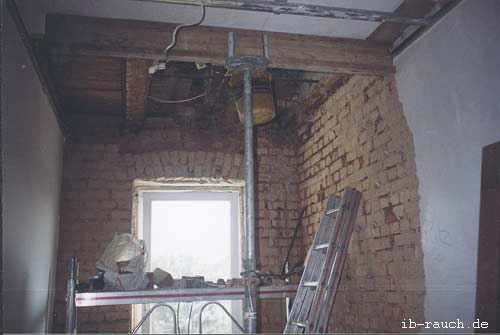
Prior investigations in Eberswalde showed that growth up to 40 cm above the visible range of a wooden beam is possible. Thus, the lower limit of the exception in DIN 68800 and in the Beuth comment on DIN with 50 cm can be regarded as a plausible quantity.
If a damage is remedied by Serpula lacrymans, it must be borne in mind that several and quite different factors play a part in the final damage.
IX. Danger to health by the real dry rot
Due to its concealed spreading especially in the wooden beam ceilings or in the cavities in the removed roof floors, the large damage to the statically supporting wooden parts is often noticed very late. Due to the reduced load-bearing capacity, a risk of collapse should always be expected until the extent of the damage is determined with a thorough investigation.
In case of intense infestations, gaseous metabolic products of the fungus should cause headaches and nausea. The spore dust can cause violent spore allergies. [O. Schwantes 95 / S. 227 and 262] However, high concentrations must be present in the building. Other health impairments of Serpula lacrymans are not known.
X. Other types of house sponges
Serpula lacrimans (var. himantioides) Wild dry rot ( = Merulius silverster)
It has less destructive power than the real dry rot and is relatively rare. The temperature optimum is from 24 to 27 °C. It grows mainly outdoors in conifers and conifers in the building. It is less common in buildings. The fruit bodies are thinner, without bulging margins, and never form consoles. The mycelium is only as thick as a twine.
Serpula minor
It occurs primarily in buildings, but does not have the destructive power of Serpula lacrimans. Has smaller spores and white mycelial strands.
Leucogyrophana pulverulenta
(Perhaps this could be the Serpula minor, since the descriptions are the same, but no clear statement could be found in the literature.)
The fruit bodies are more delicate and reach a diameter of max. 15 & quot; cm. The thickness becomes about 1 to 2 cm, are very shallow and have a white edge. Optimum growth temperature 18 to 22 & nbsp; °C. The fungus predominantly affects conifers.
Serpula pinastri, Leucogyrophana pinastri
Is also a brown rot fungus of wood (predominantly softwood), but with us very rarely. It requires higher initial humidities of the wood, but can cause considerable damage in its occurrence. The fruit bodies can reach a diameter of 15 to 20 cm. The thickness hardly reaches 5 & nbsp; mm. The mycelium is chy color to yellowish gray and much thinner. The fibrous hyphae are absent in the yellowish-brown strand mycelium.
Serpula eurocephala
Grows on living and dead bamboo and can cause considerable damage in the tropics of bamboo. These species grow in the tropics of South America, Africa, Asia and Australia.
In several federal states, as well as in Saxony, the infestation by the real dry rot is subject to the obligation of the building authorities to report in accordance with the building regulations (eg, SächsBO § 16 para. 2). The fight against and the elimination of damage must be carried out by a specialist company on the basis of an assessment by an expert.
Firstly, the causes and possible sources of moisture must be eliminated.
If an immediate, complete restoration can not take place, the growth of the fungus should be largely prevented. An important basis is the exposure of the damage area so that the wooden beams or other load-bearing wooden parts can dry well by air rinsing. Also direct sunlight reduces the growth rate. The spread of damage is also visible and appropriate, reasonable safeguards, such as support, blocking of the damage area can be carried out. Without exposure and determination of the spread, the infestation remains an unpredictable risk.
The measures for combating the infestation by the real house sponge can be found in the leaflet 1-2-03 / D of the Scientific-Technical Working Group for the Preservation of Monuments and Sites (WTA) and DIN 6800 part 4.
It is not advisable to carry out a clean-up operation without professional support.
XII. References to the real dry rot: (incomplete)
- Polanyi, Peter; Holzschutz ohne Menschenschaden: Farben, Lacke und Holzschutzmittel anwenden ohne sich und die Umwelt zu vergiften 19992 Quelle: Deut. Bücherei Leipzig 1992 A 26962
- Weissenfeld; Peter; Holzschutz ohne Gift?: Holzschutz und Oberflächenbehandlung, Quelle: Deut. Bücherei Leipzig 1990 A 28536
- Müller,Klaus; Holzschutz in Tabellenform, Wissenspeicher, Inst. für Weiterbildung Bauwesen Leipzig 1985, Quelle: Deut. Bücherei Leipzig 1985 A 24441
- Hausschwamm an Holzbauteilen IRB 1990; Quelle: Deut. Bücherei Leipzig SA31458-1716
- Hofmeister, Gertraud; Bauschäden an der Altbausubstanz in den neuen Bundesländern (Feuchtraum, Bad, Küche) Forschungsbericht 1995; Quelle: Deutsche Bücherei Leipzig 1996 B 1555
- Hofmeister, Gertraud; Bauschäden an Holzbalkendecke in Feuchtraumbereichen ... Forschungsbericht 1995; Quelle: Deut. Bücher Leipzig 1995 B 24946
- Langendorf, Günter; Holzschutz, Handbuch für Fachleute; Quelle: Deut. Bücherei Leipzig 1988 A 22932/1
- Willi, Mönck; Schäden an Holzkonstruktionen, Verlag für Bauwesen Berlin 1995 und neuere Ausgaben
- Björn Weiß, André Wagenführer, Kordula Kruse; Beschreibung und Bestimmung von Bauholzpilzen, DRW-Verlag 2000
- Müller, Ingo; Alternative Verfahren der Hausschwammbekämpfung, Vortrag Holzbaufachtagung in Quedlinburg 19.03.1999
- Rafalski, Hans-Joachim; Vortrag in Quedlinburg, Spezielles zum Echten Hauschwamm insbesondere zur Wuchsrichtungsbestimmung.
- Hubacek; Spezialgebiete der Chemie, Oldenburg Wien 1986
- DIN 68800 Teil 4; Bekämpfungsmaßnahmen gegen holzzerstörende Pilze und Insekten
- Beuth-Kommentare zum Holzschutz, Erläuterung zu DIN 68800-2,-3,-4, DGfH (Deutsche Gesell. für Holzforschung e.V.)1998 [www.din.de/beuth]
- 22. Holzschutz-Tagung "Maßnahmen zum Schutz des Holzes" in Bad Kissingen vom 17. bis 18. Oktober 2000. Vorträge, S.93-99; Herausgeber Deutsche Gesellschaft für Holzforschung (DGfH), München 2000
- brockhaus - ABC Biologie -; VEB F.A. Brockhaus Verlag Leipzig 1970 S.337
- Schmiedeknecht, Martin u.a.; Urania Pflanzenreich, Niedere Pflanzen, Verlag für populärwissenschaftliche Literatur, Leipzig 1974
- www.stud.uni-hamburg.de/users/Serpula/Gesundheitsgefahr.htm
Various & nbsp; Pictures & nbsp; To the real dry rot infestation. Further pictures were taken by Dipl.-Ing. Gerd Gatkowsky (hall) provided. Bild 1 (81 KB) Bild 2 (95 KB) Bild 3 (63 KB)
Im Auftrag des Leipziger Institut für Bildung und Forschung e.V.
Side:1 2 3 4 5 6 7 8 9 10 11 12 13 14 15 16 17 18 19 20 21
© ib-rauch.de | E-Mail | 12/2016 ![]()
